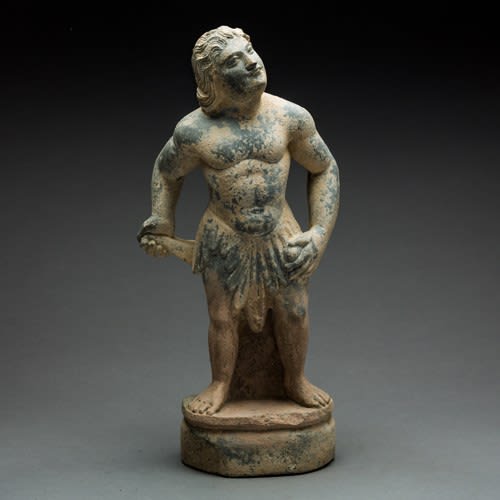Ghandaran Figure of a Male, perhaps Herakles, AD 100 - AD 300
Schist
42.2 x 18.4 x 9.6 cm
16 5/8 x 7 1/4 x 3 3/4 in
16 5/8 x 7 1/4 x 3 3/4 in
MS.1715
Further images
Gandhara art is an expression of Buddhist visual art that developed in what are now the regions of northwestern Pakistan and eastern Afghanistan, flourishing roughly between the 1st century BC...
Gandhara art is an expression of Buddhist visual art that developed in what are now the regions of northwestern Pakistan and eastern Afghanistan, flourishing roughly between the 1st century BC and the 7th century AD. The characteristics of the Gandhara style have their origins in Greek and Roman art, thriving largely during the Kushan dynasty. The territory in which Gandhara art blossomed had long been a crossroads of numerous and important cultural influences. During the reign of the Indian emperor Ashoka (3rd century AD), the region became the scene of intensive Buddhist missionary activity. And in the 1st century CE, rulers of the Kushan empire, which included Gandhara territory, maintained vivid commercial and cultural contacts with Rome. In its individual interpretation of Buddhist legends, the Gandhara school incorporated many motifs and techniques from Roman art, including vine scrolls, cherubs bearing garlands, tritons, and centaurs. The basic iconography, however, remained purely of an Indian inspiration and appearence. Stucco has a long history in the Mediterranean world and especially in Gandhara art, as it became the principal material for sculptures after the 3rd century AD. Typically consisting of crushed or burned lime or gypsum mixed with sand and water, stucco was easily molded or modeled into relief decoration for walls, ceilings, and floors in both interior and exterior spaces, as well for incredibly harmonious pieces of sculpture. The materials primarily used for the earlier phases of Gandhara sculpture though were green phyllite and gray-blue mica schist, such as the present example. In general, Gandhara sculptures were originally both painted in vibrant natural colours and gilded.
Sculpture on oval base representing a standing male youthful clean-shaven long-haired figure, wearing a type of loincloth around the waist.
The figure has oriental facial features and an accentuated musculature; with a direct turn of the neck the young man seems to be gazing intensely towards the sky.
Sculpture on oval base representing a standing male youthful clean-shaven long-haired figure, wearing a type of loincloth around the waist.
The figure has oriental facial features and an accentuated musculature; with a direct turn of the neck the young man seems to be gazing intensely towards the sky.









